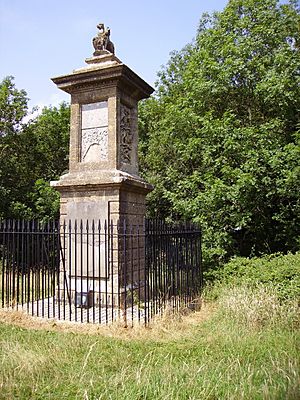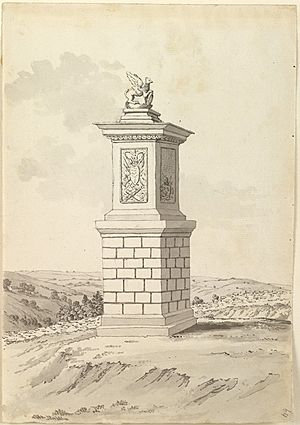Sir Bevil Grenville's Monument facts for kids
Quick facts for kids Sir Bevil Grenville's Monument |
|
|---|---|

Sir Bevil Grenville's monument, at the place where on 5 July 1643 he fell mortally wounded
|
|
| Location | Lansdown, Bath, England |
| Built | 1720 |
|
Listed Building – Grade II*
|
|
| Official name: Monument to Sir Bevil Grenville at NGR ST 7219 7034 | |
| Designated | 1 February 1956 |
| Reference no. | 1214434 |
| Official name: Sir Bevil Grenville's Monument | |
| Designated | 12 December 1950 |
| Reference no. | 1015110 |
| Lua error in Module:Location_map at line 420: attempt to index field 'wikibase' (a nil value). | |
Sir Bevil Grenville's Monument is a tall stone structure built in 1720. It stands on Lansdown Hill, about 4 miles (6.4 km) north-west of Bath, England. This monument is a very important historical site. It is recognized as a Grade II* listed building and an ancient monument.
The monument honors Sir Bevil Grenville (1596–1643). He was a brave commander during the English Civil War. Sir Bevil was a Royalist, meaning he supported King Charles I. He was from Stowe, Kilkhampton in Cornwall and Bideford in Devon. On July 5, 1643, he was badly hurt in the Battle of Lansdowne. He was leading his soldiers, who were Cornish pikemen, when he fell. His grandson built the monument, and his family has kept it in good condition ever since.
Contents
The Battle of Lansdowne
The Battle of Lansdowne happened on July 5, 1643. This was during the English Civil War. In this war, the King's supporters (called Royalists) fought against the Parliament's supporters (called Parliamentarians).
Who Fought in the Battle?
The Royalist army was led by Lord Hopton. The Parliamentarian army was led by Sir William Waller. Waller's troops were in a strong position on Lansdowne Hill.
Sir Bevil's Role
Sir Bevil Grenville led a group of Cornish pikemen. They bravely attacked Waller's defenses. At the same time, Royalist soldiers with muskets went around Waller's army through the woods. Sir Bevil was hurt in close fighting. He received a serious blow to his head. He was taken to a nearby house in Cold Ashton but sadly died there. Many people believed that the King's cause in the West of England suffered greatly after Sir Bevil's death.
Building the Monument
The monument was built in 1720. It was put up by George Granville, 1st Baron Lansdowne (1666–1735). He was Sir Bevil's grandson. George was also the closest male relative to William Granville, 3rd Earl of Bath (died 1711). William was Sir Bevil's great-grandson and the last male in the main family line.
Other Memorials
Before building this monument, Baron Lansdowne had already put up a memorial for Sir Bevil. This was in 1714. It was placed inside the Grenville Chapel. This chapel is in the Church of St James the Great in Kilkhampton, Cornwall. The Grenville family home, Stowe, was in that area.
Keeping it Repaired
The monument has been fixed many times over the years. Repairs happened in 1777, 1828, and 1879. Each time, Sir Bevil's descendants paid for the work. It's interesting to know that Sir Bevil's name was originally spelled "Granville." Today, "Grenville" or "Greville" are more common.
What the Monument Looks Like
The monument is made of ashlar stone. This means the stones are carefully cut and shaped. It stands 25 feet (7.6 meters) tall. The style of the monument is English Baroque. This is a grand and decorative style of architecture.
Inscriptions and Symbols
On the south side of the monument, there is a slate tablet. It has words from a book called History of the Rebellion and Civil Wars in England. This book was written by Lord Clarendon. It describes the Battle of Lansdowne.
On the north side, there are two poems. At the very top of the monument, there is a griffin. A griffin is a mythical creature with the body of a lion and the head and wings of an eagle. This griffin is the symbol of the Grenville family. It holds a shield with the Grenville family's coat of arms. The shield shows three golden "clarions" (a type of trumpet) on a red background.
Another side of the monument shows the Royal Arms of King Charles II. These arms are supported by the arms of Sir Bevil's oldest son, John Granville, 1st Earl of Bath. They are also supported by the arms of General George Monck, 1st Duke of Albemarle. General Monck was very important in bringing King Charles II back to the throne in 1660. Sir John Grenville helped him a lot with this. Because of their help, both men were given special titles by the King.
The Poem on the Monument
A poem called Elegy on Sir Bevil Grenville is carved on the monument. It was written by William Cartwright. He was also a Royalist and died shortly after Sir Bevil in 1643. The poem says:
This was not Nature’s courage nor that thing,
We valour call which Time and Reason bring,
But a diviner fury fierce and high,
Valour transported into Ecstasy.
This poem means that Sir Bevil's bravery was not just normal courage. It was a very strong and special kind of bravery, almost like a powerful, divine feeling.
See also
 In Spanish: Monumento a sir Bevil Grenville para niños
In Spanish: Monumento a sir Bevil Grenville para niños


